Influences of Initial Surface Conditions on Response Characteristics of Amorphous Silicon Films to Nanosecond Laser Irradiation
Abstract
:1. Introduction
2. Materials and Methods
2.1. Amorphous Silicon Films
2.2. Laser Irradiation Conditions
2.3. Simulation of Laser Irradiation
2.4. Measurement and Characterization Methods
3. Results and Discussion
3.1. Initial Surface Conditions
3.2. Unpolished Amorphous Silicon Surface
3.2.1. Effects of Repetition Frequency
3.2.2. Effects of Laser Beam Overlap Ratio
3.2.3. Effects of Laser Average Power
3.3. Polished Amorphous Silicon Surface
3.4. Energy-Dispersive X-ray Spectroscopy Analysis
3.5. Raman Spectroscopy Analysis
3.6. Formation Mechanism of Micro-Protrusions
3.7. Characteristics of the Polished Surface
3.8. Surface Defects Analysis
4. Conclusions
- A completely different phenomenon appeared after laser irradiation of the unpolished and polished silicon film surfaces. There were mainly cracks, attachments, nano-sized pores, and bumps on the irradiated unpolished surface, while there were mainly corrosive pitting, debris, and slag on the irradiated polished surface because the surface stress layer was removed by the polishing process.
- Periodic micro-protrusions could be obtained on the unpolished amorphous silicon surface, but not on the polished surface. The main irradiation parameters affecting the formation of micro-protrusions were the laser beam overlap ratio, repetition frequency, and average power, among which the most crucial parameter was the repetition frequency.
- At a repetition frequency of 140 kHz under a peak power intensity of 4.65 × 109 W/cm2, periodic micro-protrusions with an average height of 0.3 μm and the same roughness as the initial surface could be obtained.
- The formation of micro-protrusions was related to the fluctuations of the solid–liquid interface caused by continuous laser pulse shocks during laser irradiation. Owing to the instantaneous heating-cooling cycle (107 K/s) between laser pulses, there was insufficient time for the surface tension to flatten the instantaneously solidified local regions on the solid–liquid interface. This type of heating-cooling cycle enabled top-down melting and bottom-up protrusion growth.
- The non-formation of micro-protrusions was probably due to polish-induced surface planarization and homogenization. Raman analysis showed that the amorphous silicon film crystallized during laser irradiation. The removal of surface stress and reduction in surface roughness were both verified.
Author Contributions
Funding
Conflicts of Interest
References
- Nishimoto, T.; Takai, M.; Miyahara, H.; Kondo, M.; Matsuda, A. Amorphous silicon solar cells deposited at high growth rate. J. Non-Cryst. Solids 2002, 299, 1116–1122. [Google Scholar] [CrossRef]
- Madan, A. Flexible displays and stable high efficiency four terminal solar cells using thin film silicon technology. Adv. Manuf. Process. 2007, 22, 412–418. [Google Scholar] [CrossRef]
- Derkacs, D.; Lim, S.H.; Matheu, P.; Mar, W.; Yu, E.T. Improved performance of amorphous silicon solar cells via scattering from surface plasmon polaritons in nearbymetallic nanoparticles. Appl. Phys. Lett. 2006, 89, 514–518. [Google Scholar] [CrossRef] [Green Version]
- He, L.; Xu, J.; Dekai, Z.; Yang, Q.H.; Li, L.O. Potential application of functional micro-nano structures in petroleum. Pet. Explor. Dev. 2018, 45, 745–753. [Google Scholar]
- Xiang, T.; Hou, J.W.; Xie, H.; Liu, X.; Gong, T.; Zhou, S.B. Biomimetic micro/nano structures for biomedical applications. Nano Today 2020, 35, 100980. [Google Scholar] [CrossRef]
- Huang, H.; Jiang, M.Q.; Yan, J.W. Softening of Zr-based metallic glass induced by nanosecond pulsed laser irradiation. J. Alloy. Compd. 2018, 754, 215–221. [Google Scholar] [CrossRef] [Green Version]
- Huang, C.R.; Lee, M.C.; Chang, Y.S. Optical and Raman correlation of laser recrystallised and quenched amorphous silicon film: A microprobe study. J. Phys. D Appl. Phys. 1990, 23, 729–734. [Google Scholar] [CrossRef]
- Grigoropoulos, C.P.; Moon, S.; Lee, M. Thermal transport in melting and recrystallization of amorphous and polycrystalline Si thin films. Appl. Phys. A 1999, 69, S295–S298. [Google Scholar] [CrossRef]
- Lee, M.; Moon, S.; Hatano, M. Relationship between fluence gradient and lateral grain growth in spatially controlled excimer laser crystallization of amorphous silicon films. J. Appl. Phys. 2000, 88, 4994–4999. [Google Scholar] [CrossRef]
- Soederstroem, T.; Haug, F.J.; Terrazzoni-Daudrix, V.; Ballif, C. Optimization of amorphous silicon thin film solar cells for flexible photovoltaics. J. Appl. Phys. 2008, 103, 27–33. [Google Scholar] [CrossRef]
- Huang, H.; Lu, L.; Wang, J.W.; Jie, Y.; Leung, S.F.; Di, C.; Chen, X.; Shen, G. Performance enhancement of thin-film amorphous silicon solar cells with low cost nanodent plasmonic substrates. Energy Environ. Sci. 2013, 6, 2965–2971. [Google Scholar] [CrossRef]
- Jian, C.; Liu, C.S.; Shang, S.; Perrie, W.; Dearden, G.; Watkins, K. A review of ultrafast laser materials micromachining. Opt. Laser Technol. 2013, 46, 88–102. [Google Scholar]
- Wang, Y.; Liu, W.; Xin, W.; Zou, T.; Guo, C. Back-Reflected Performance-Enhanced Flexible Perovskite Photodetectors through Substrate Texturing with Femtosecond Laser. ACS Appl. Mater. Interfaces 2020, 12, 26614–26623. [Google Scholar] [CrossRef]
- Malinauskas, M.; Zukauskas, A.; Hasegawa, S.; Hayasaki, Y.; Mizeikis, V.; Buividas, R.; Juodkazis, S. Ultrafast laser processing of materials: From science to industry. Light Sci. Appl. 2016, 5, e16133. [Google Scholar] [CrossRef] [Green Version]
- Svrcek, V.; Mariotti, D.; Cvelbar, U.; Filipi, G.; Lozach, M.; Mcdonald, C.; Tayagaki, T.; Matsubara, K. Environmentally friendly processing technology for engineering silicon nanocrystals in water with laser pulses. J. Phys. Chem. C 2016, 120, 18822–18830. [Google Scholar] [CrossRef]
- Borisov, R.A.; Dorojkina, G.N.; Koroteev, N.I. Femtosecond two-photon photopolymerization: A method to fabricate optical photonic crystals with controllable parameters. Laser Phys. 1998, 8, 1105–1108. [Google Scholar]
- Her, T.H.; Finlay, R.J.; Wu, C. Microstructuring of silicon with femtosecond laser pulses. Appl. Phys. Lett. 1998, 73, 1673–1675. [Google Scholar] [CrossRef]
- Niitsu, K.; Yan, J.W. Effects of deep subsurface damages on surface nanostructure formation in laser recovery of grinded single-crystal silicon wafers. Precis. Eng. 2019, 62, 213–222. [Google Scholar] [CrossRef]
- Kang, M.J.; Park, T.S.; Kim, M.; Hwang, E.S.; Kim, S.H.; Shin, S.T.; Cheong, B.H. Periodic surface texturing of amorphous-Si thin film irradiated by UV nanosecond laser. Opt. Mater. Express 2019, 9, 4247–4255. [Google Scholar] [CrossRef]
- Hong, L.; Wang, X.; Rusli; Wang, H.; Zheng, H.; Yu, H. Crystallization and surface texturing of amorphous-Si induced by UV laser for photovoltaic application. J. Appl. Phys. 2012, 111, 1353–1358. [Google Scholar] [CrossRef]
- Jiao, L.G.; Li, J.S.; Yuan, C.; Jiang, H.M.; Zhao, G.M. Irradiation effects of continuous laser on liquid tank: A natural convection study. Int. J. Heat Mass Transf. 2014, 77, 970–978. [Google Scholar] [CrossRef]
- Stephan, K.; Abdelsalam, M. Heat-transfer correlations for natural convection boiling. Int. J. Heat Mass Transf. 1980, 23, 73–87. [Google Scholar] [CrossRef]
- Kumar, N.; Dash, S.; Tyagi, A.K.; Raj, B. Dynamics of plasma expansion in the pulsed laser material interaction. Sadhana 2010, 35, 493–511. [Google Scholar] [CrossRef] [Green Version]
- Ghosh, G. Temperature dispersion of refractive indices in crystalline and amorphous silicon. Appl. Phys. Lett. 1995, 66, 3570–3572. [Google Scholar] [CrossRef]
- Xu, Z.W.; Zhong, D.; He, Y. Topic Review: Application of Raman Spectroscopy Characterization in Micro/Nano-Machining. Micromachines 2018, 9, 361. [Google Scholar] [CrossRef] [Green Version]
- Kundu, P.P.; Tripathy, D.K.; Banerjee, S. Studies on the miscibility of blends of polychloroprene and poly (ethylene-methyl acrylate) copolymer. Polymer 1996, 37, 2423–2431. [Google Scholar] [CrossRef]
- Bissett, M.A.; Izumida, W.; Saito, R.; Ago, H. Effect of domain boundaries on the Raman spectra of mechanically strained graphene. ACS Nano 2012, 6, 10229–10238. [Google Scholar] [CrossRef]
- Chen, G.; Bi, J. Analytical solutions for three-dimensional modeling of temperature rise inside solid material induced by laser irradiation. Optik 2016, 132, 80–88. [Google Scholar] [CrossRef]
- Xu, X.; Grigoropoulos, C.P.; Russo, R.E. Measurement of solid–liquid interface temperature during pulsed excimer laser melting of polycrystalline silicon films. Appl. Phys. Lett. 1994, 65, 1745–1747. [Google Scholar] [CrossRef] [Green Version]
- Hatano, M.; Moon, S.; Lee, M. Excimer laser-induced temperature field in melting and resolidification of silicon thin films. J. Appl. Phys. 2000, 87, 36–43. [Google Scholar] [CrossRef]
- Ikegami, M.; Weaver, T.E.; Grant, S.N.; Whitsett, J.A. Pulmonary surfactant surface tension influences alveolar capillary shape and oxygenation. Am. J. Respir. Cell Mol. Biol. 2009, 41, 433–439. [Google Scholar] [CrossRef] [PubMed]
- Liu, N.; Huang, W.M.; Phee, S.J.; Tong, T.H. The formation of micro-protrusions atop a thermo-responsive shape memory polymer. Smart Mater. Struct. 2008, 17, 057001. [Google Scholar] [CrossRef]
- Kushnira, V.V.; Rubashkinaa, M.V.; Svetlichnyia, A.M. The formation of submicron structures on the surface of amorphous silicon films by nanosecond pulsed radiation of a laser line generator. Nanotechnol. Russia 2012, 7, 457–462. [Google Scholar] [CrossRef]
- Franta, B.; Mazur, E.; Sundaram, S.K. Ultrafast laser processing of silicon for photovoltaics. Int. Mater. Rev. 2017, 35, 1–14. [Google Scholar] [CrossRef]
- Kobayashi, T.; Yan, J.W. Generating nanodot structures on stainless-steel surfaces by cross scanning of a picosecond pulsed laser. Nanomanuf. Metrol. 2017, 3, 105–111. [Google Scholar] [CrossRef]
- Xu, K.; Zhang, C.T.; Zhou, R.; Ji, R.; Hong, M.H. Hybrid micro/nano-structure formation by angular laser texturing of Si surface for surface enhanced Raman scattering. Opt. Expres. 2016, 24, 10352–10358. [Google Scholar] [CrossRef]
- Huang, H.; Qian, Y.F.; Wang, C.; Yan, J.W. Laser induced micro-cracking of Zr-based metallic glass using 1011 W/m2 nano-pulses. Mater. Today Commun. 2020, 25, 101554. [Google Scholar] [CrossRef]
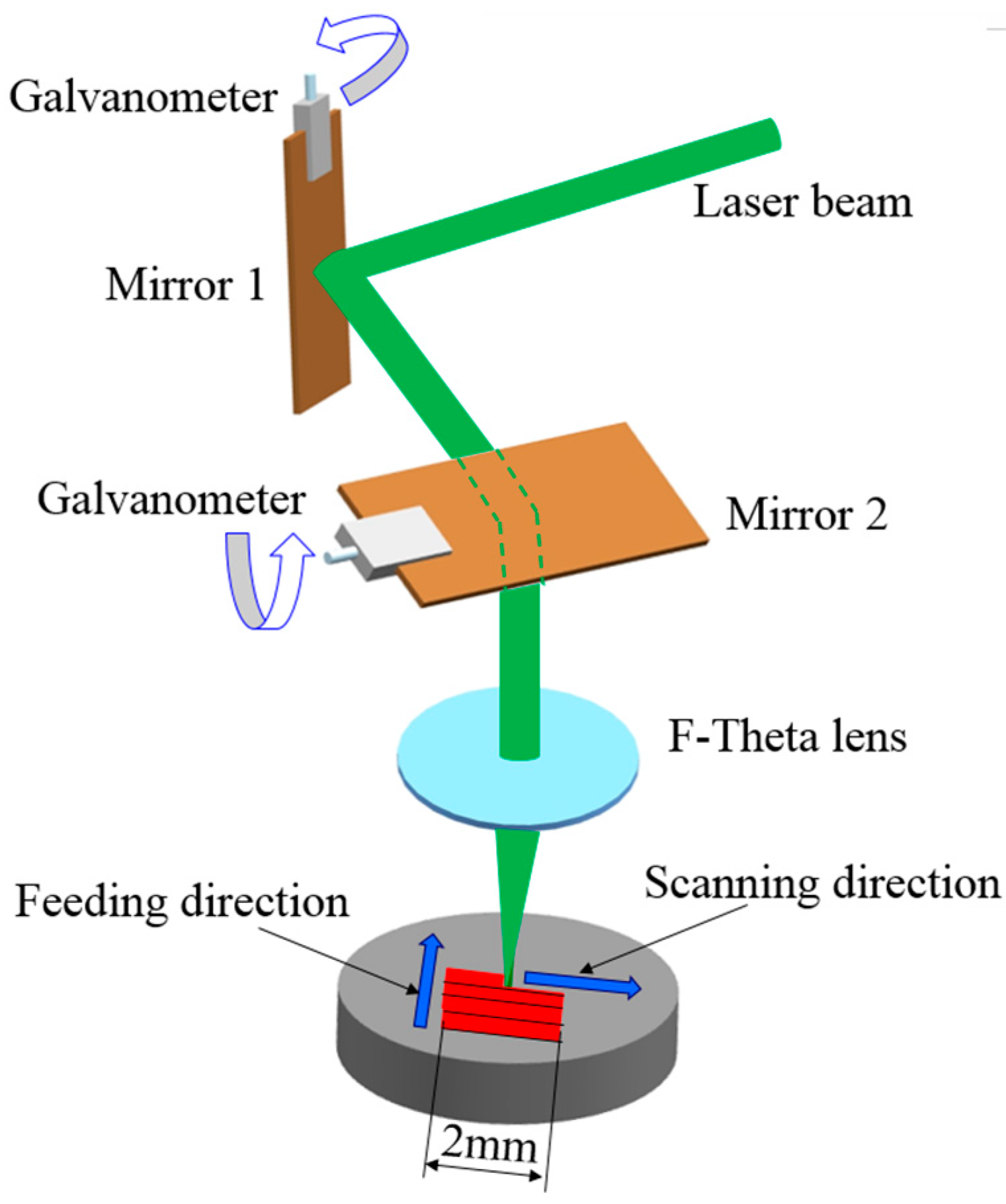
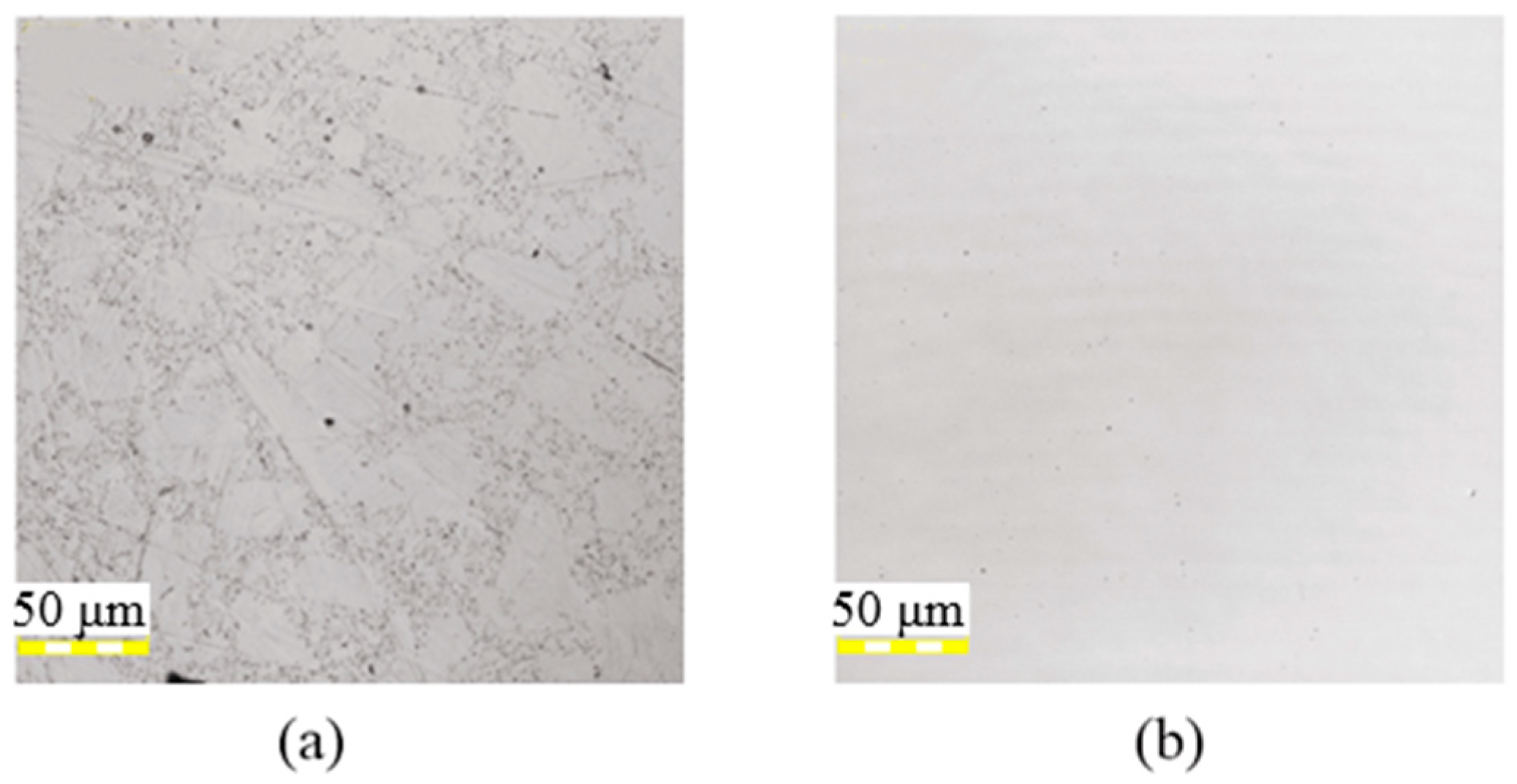

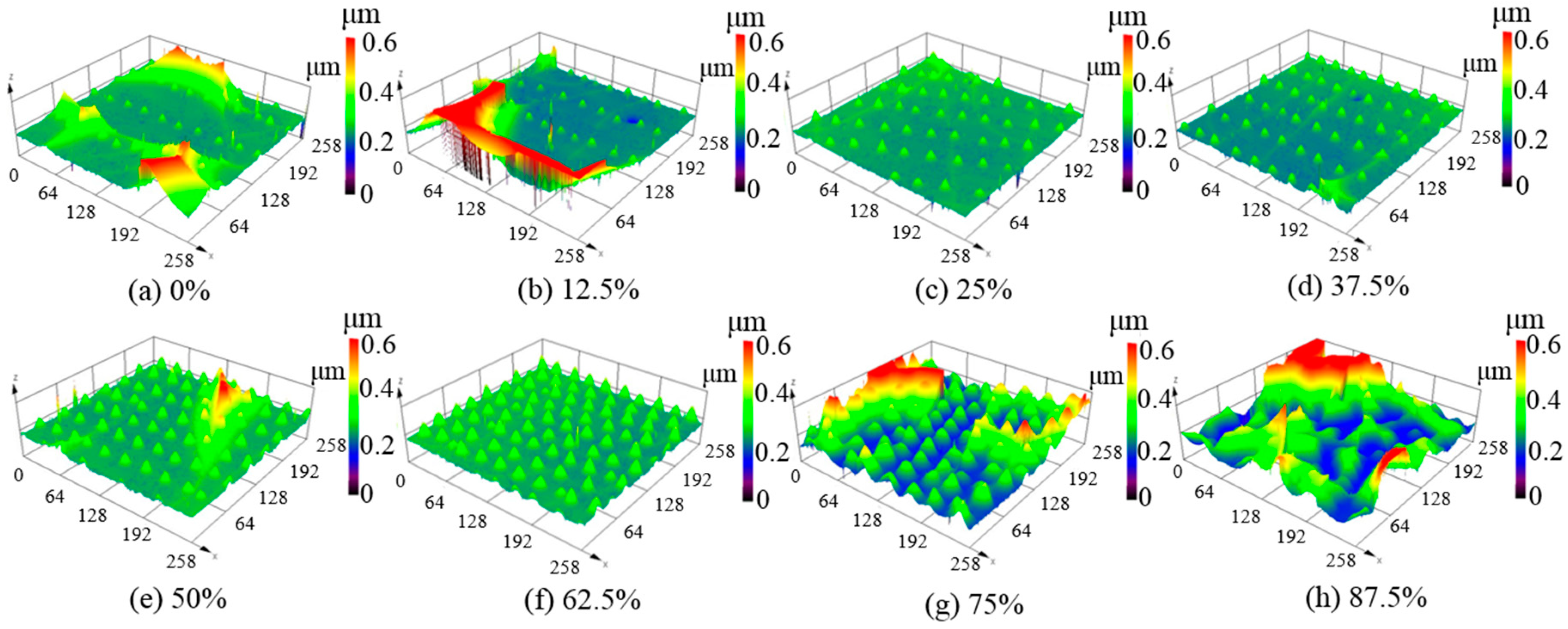
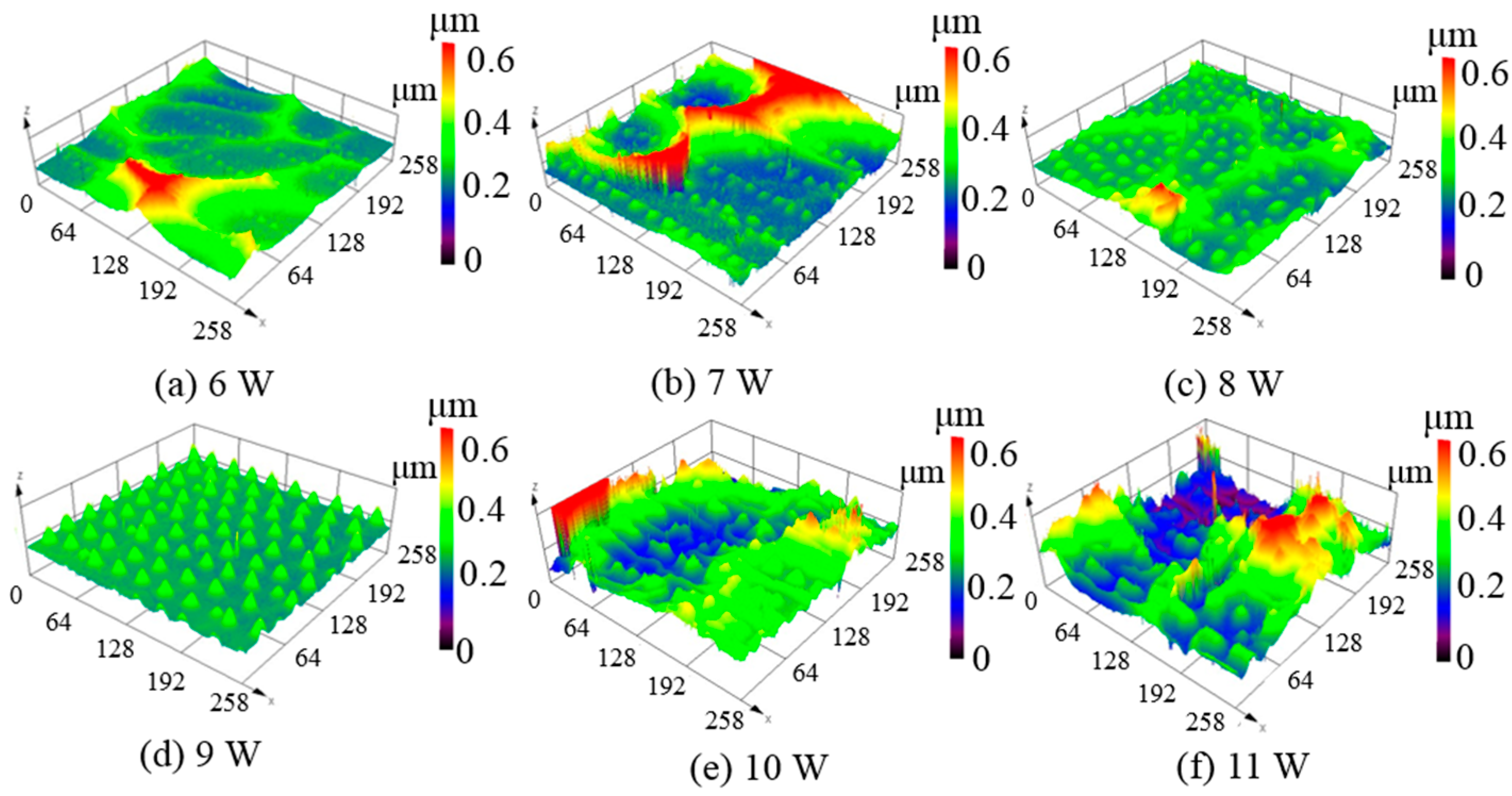
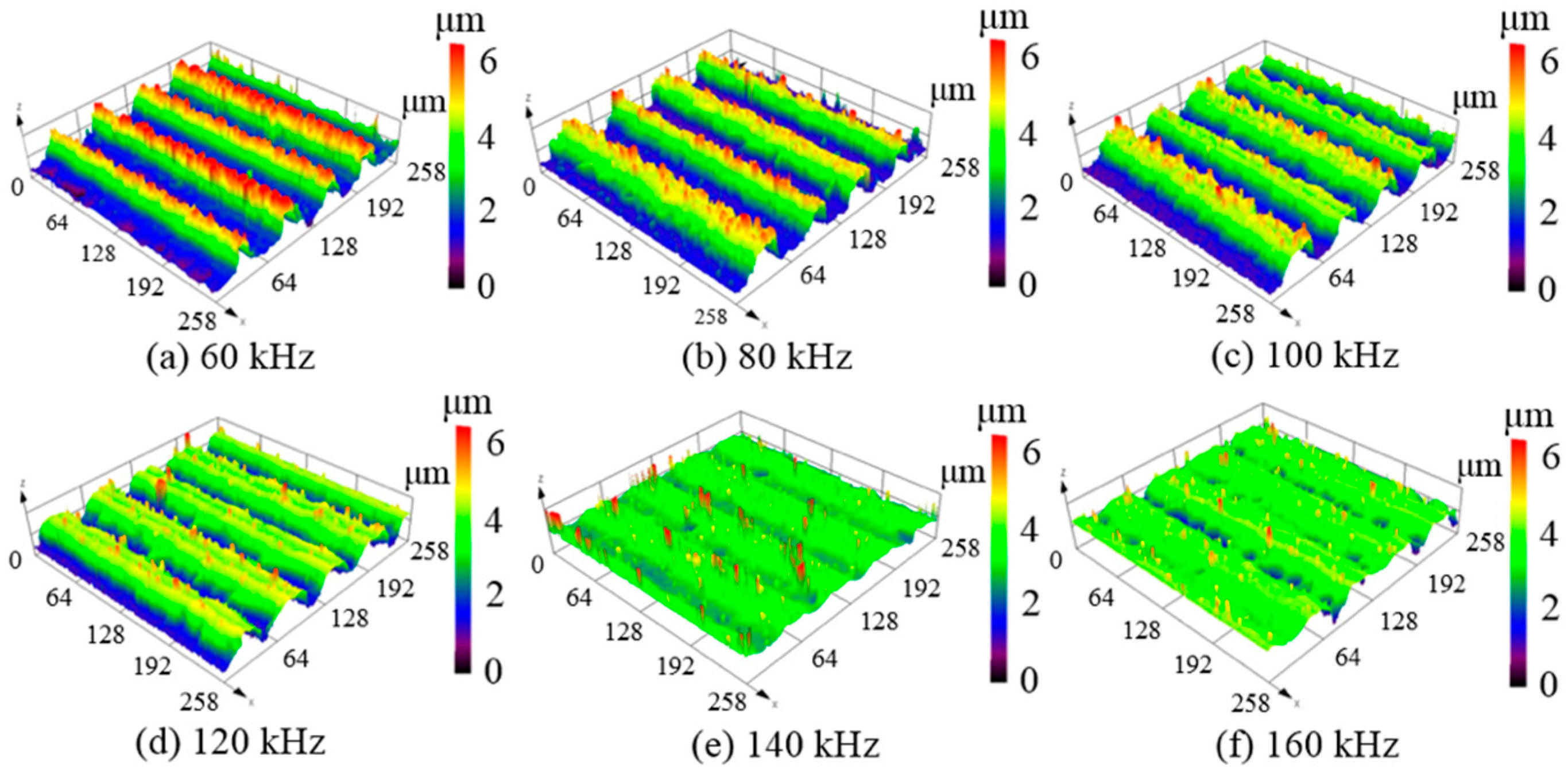


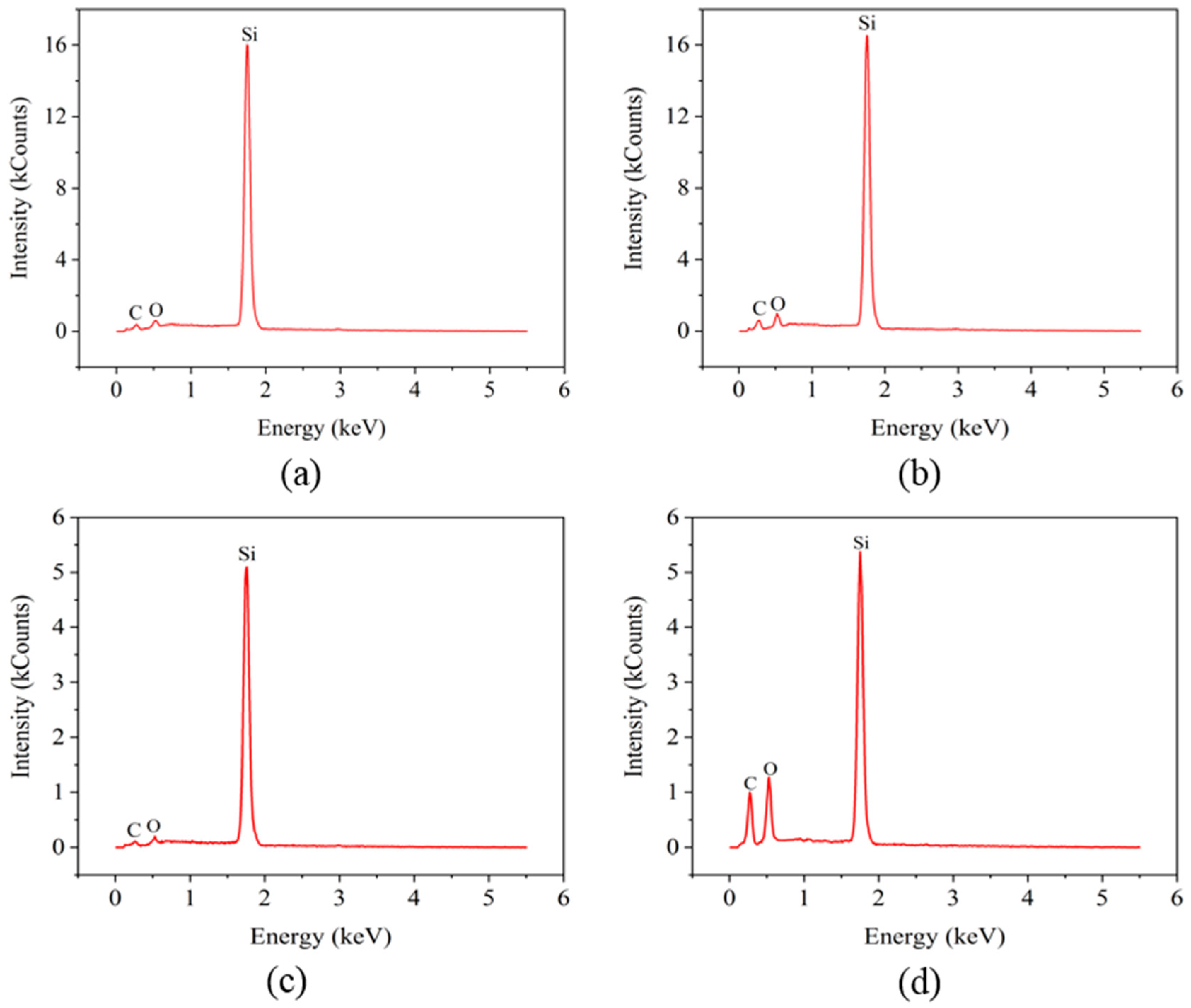
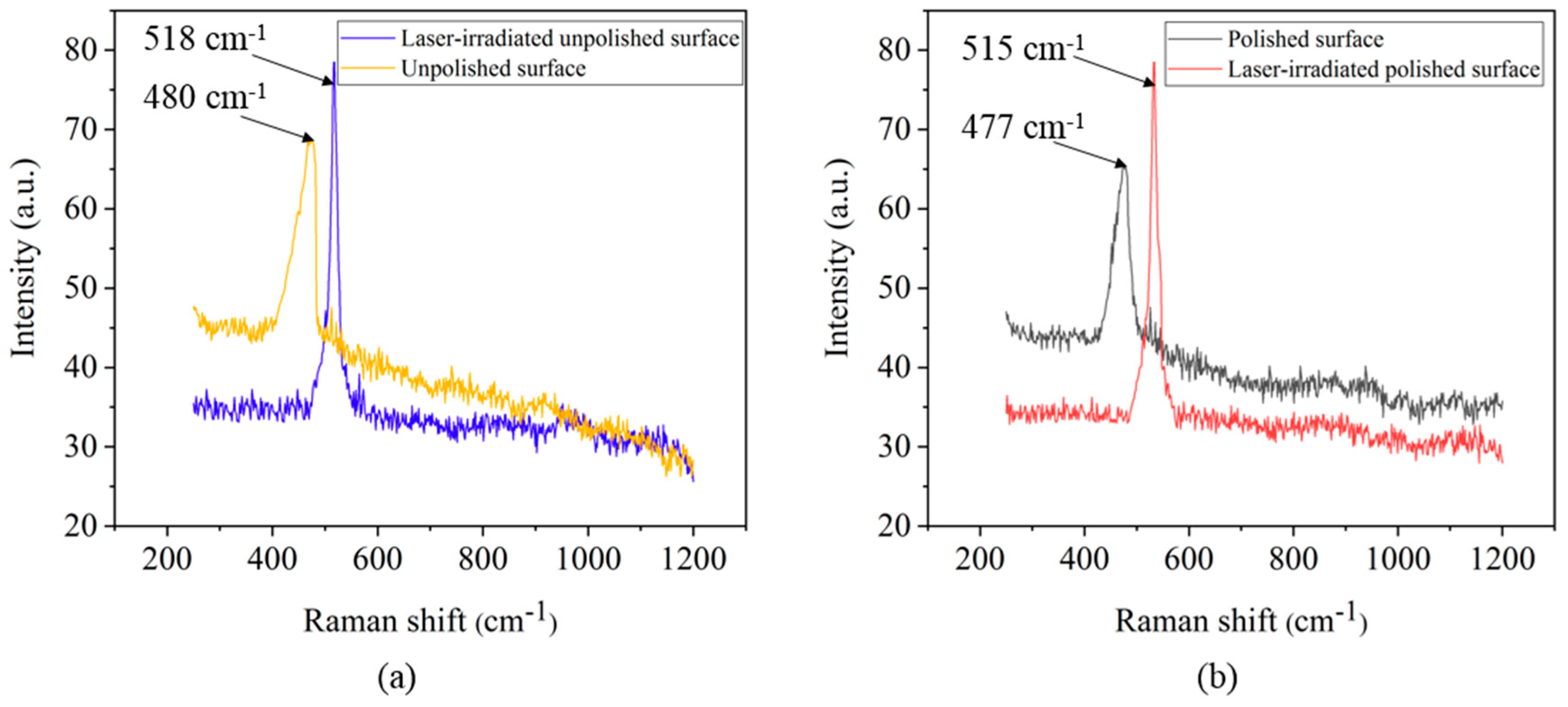
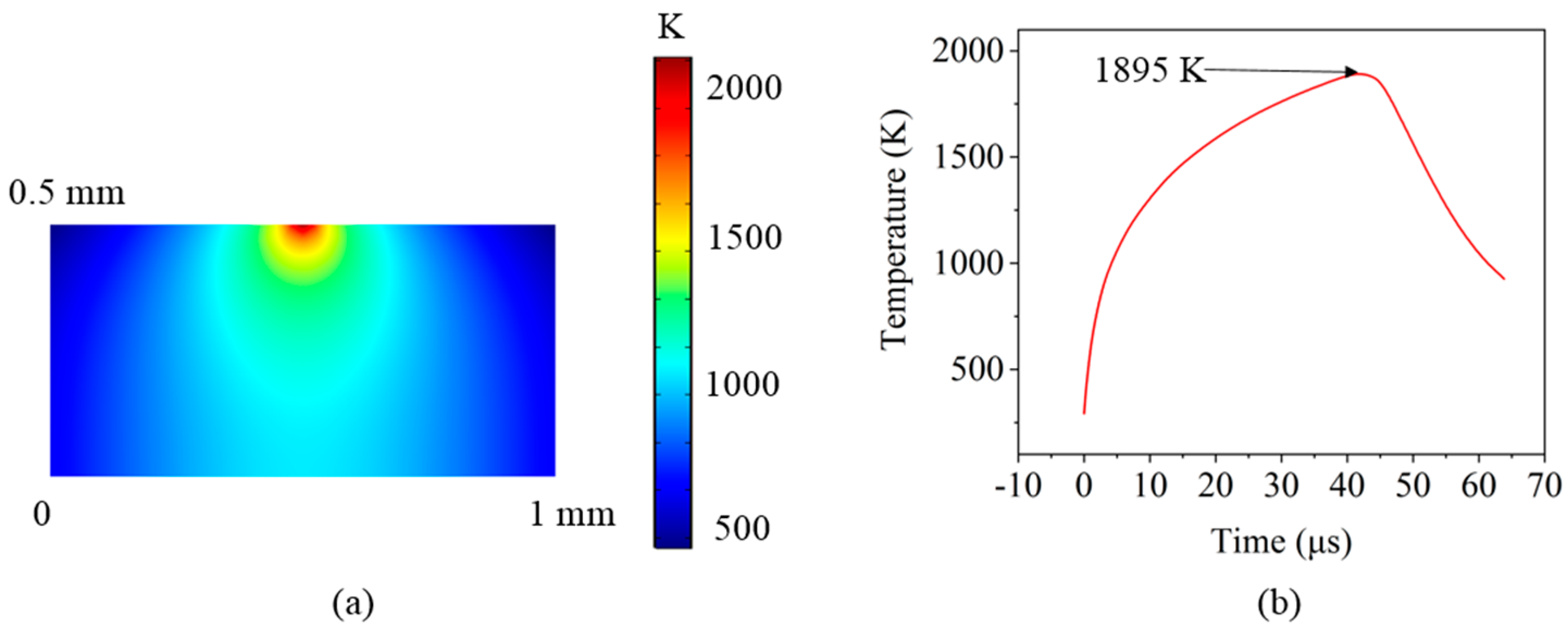
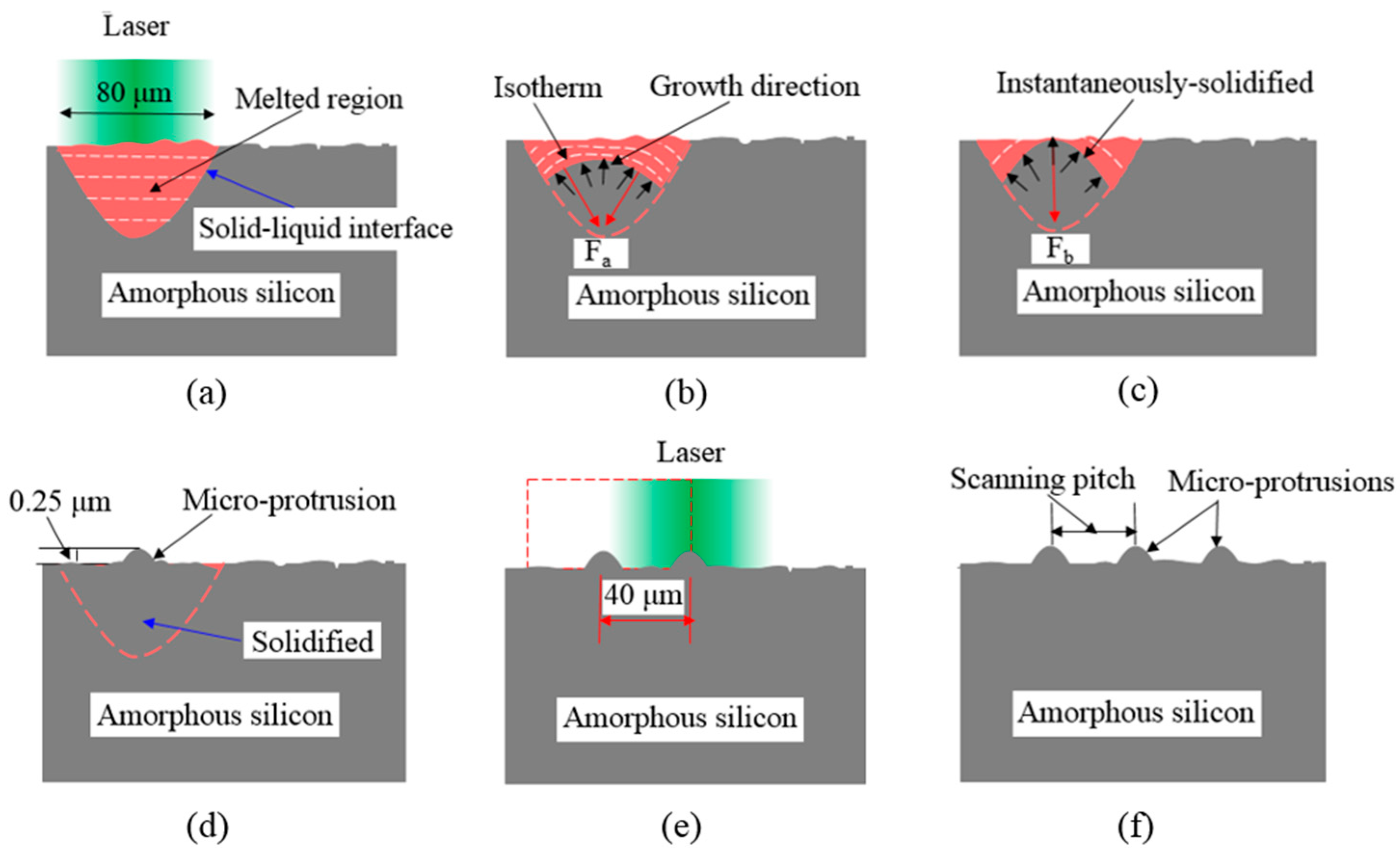
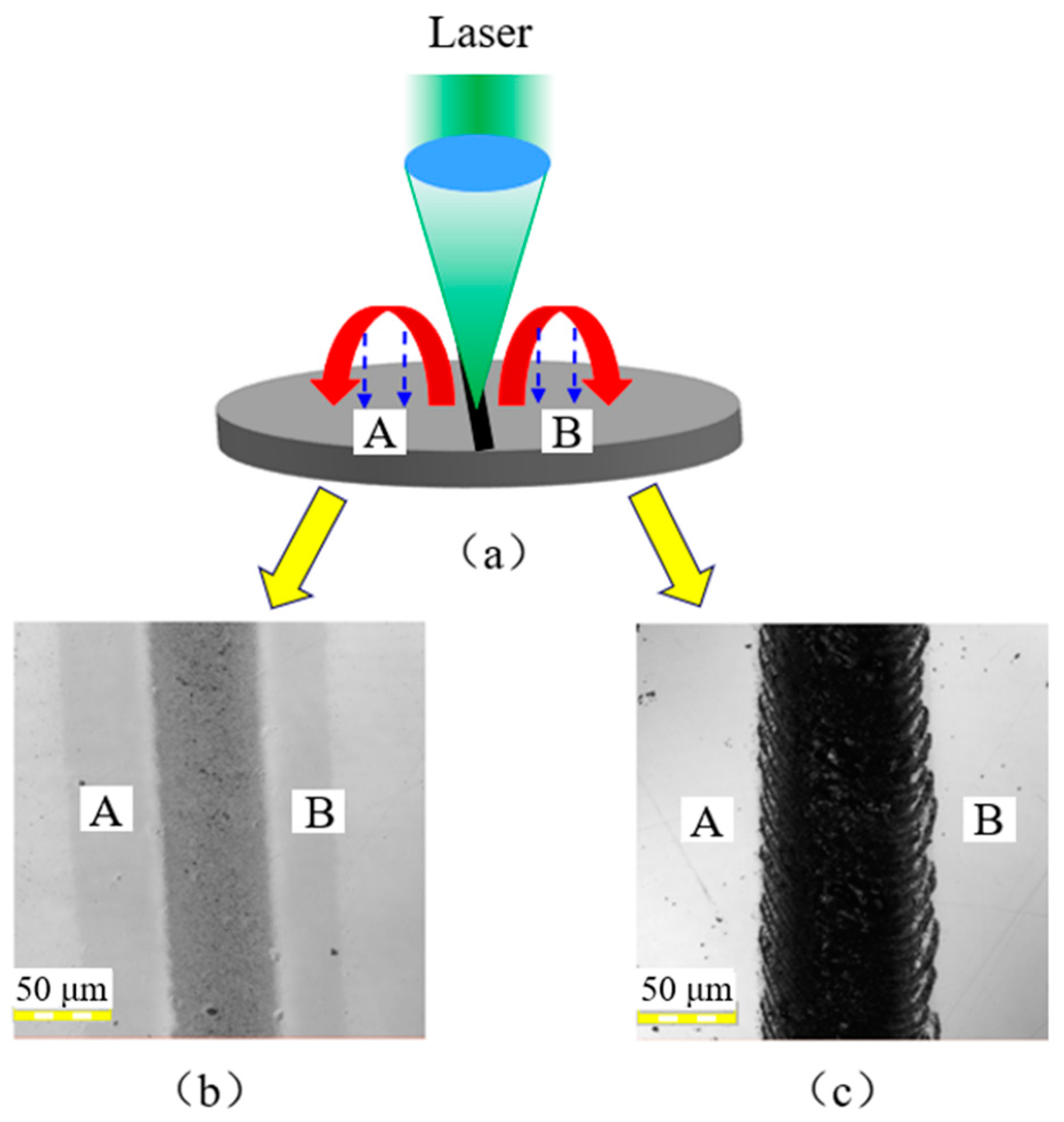
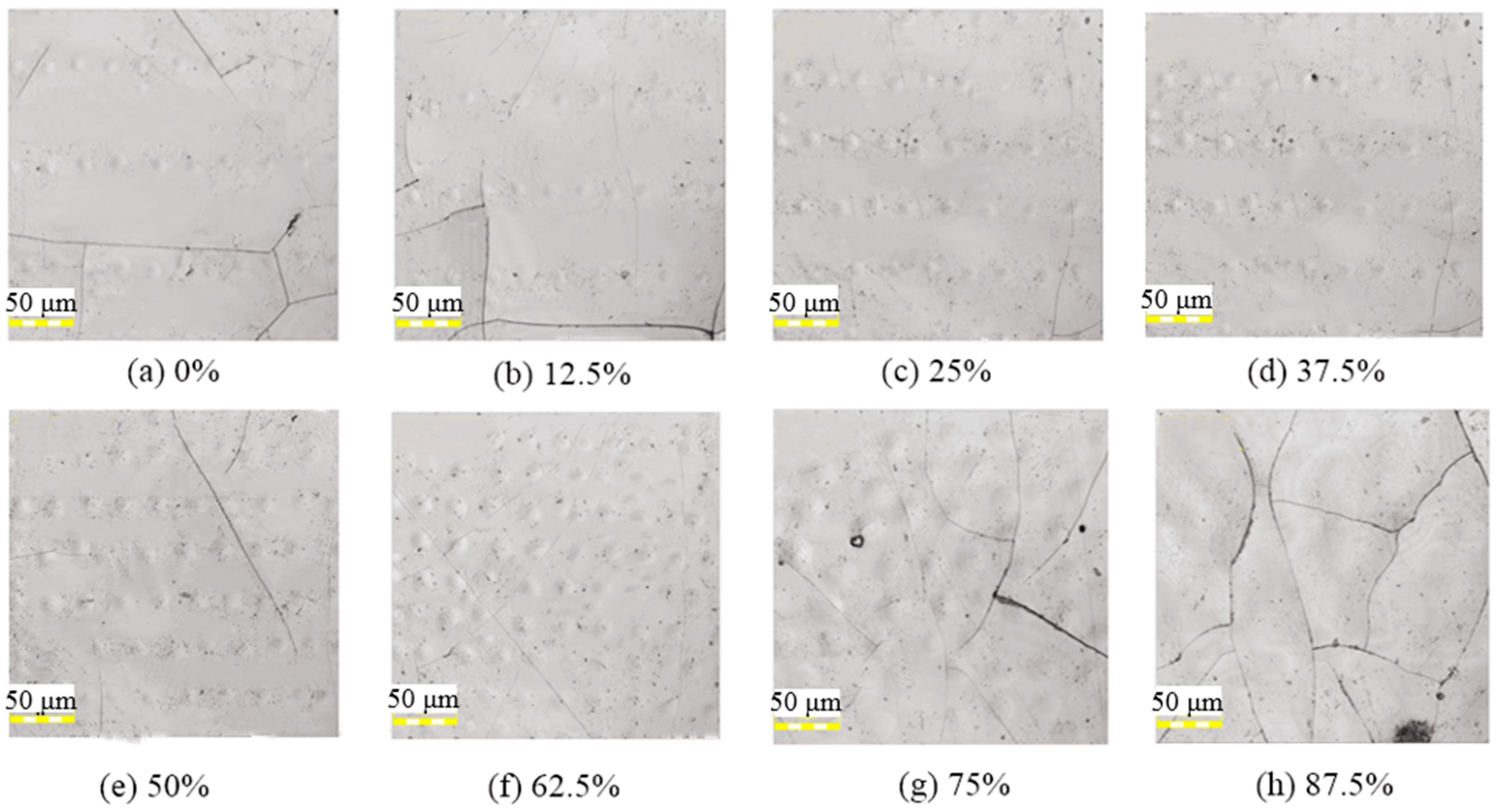
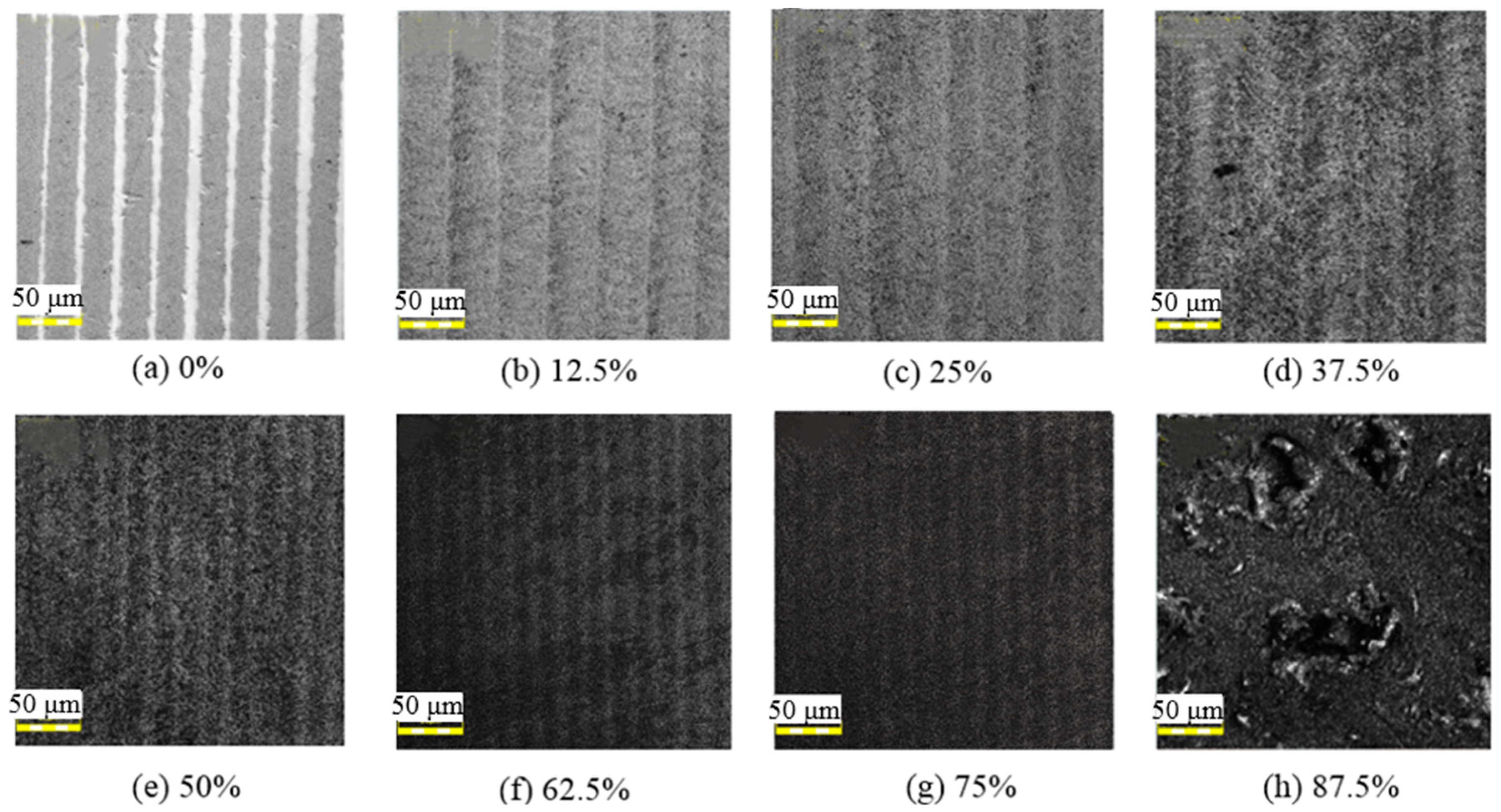
| Items | Parameters |
|---|---|
| Laser type | Nanosecond pulsed laser |
| Wavelength | 532 nm |
| Pulse width | 46 ns |
| Laser average power | 6−15 W |
| Repetition frequency | 30−160 kHz |
| Scanning pitch | 10−80 μm |
| Scanning velocity | 50 mm/s |
| Beam overlap ratio | 0−87.5% |
| Irradiation region | 2 × 2 mm2 |
| Environment | Air at ambient temperature |
| O Element | Total (kCounts) | Initial Value (kCounts) | Final Value (kCounts) | Increment (kCounts) |
|---|---|---|---|---|
| Unpolished surface | 17.03 | 0.25 | 0.68 | 0.43 |
| Polished surface | 5.20 | 0.48 | 0.08 | 0.40 |
Publisher’s Note: MDPI stays neutral with regard to jurisdictional claims in published maps and institutional affiliations. |
© 2021 by the authors. Licensee MDPI, Basel, Switzerland. This article is an open access article distributed under the terms and conditions of the Creative Commons Attribution (CC BY) license (https://creativecommons.org/licenses/by/4.0/).
Share and Cite
Ren, Y.; Zhang, Z. Influences of Initial Surface Conditions on Response Characteristics of Amorphous Silicon Films to Nanosecond Laser Irradiation. Micromachines 2021, 12, 807. https://doi.org/10.3390/mi12070807
Ren Y, Zhang Z. Influences of Initial Surface Conditions on Response Characteristics of Amorphous Silicon Films to Nanosecond Laser Irradiation. Micromachines. 2021; 12(7):807. https://doi.org/10.3390/mi12070807
Chicago/Turabian StyleRen, Yingming, and Zhiyu Zhang. 2021. "Influences of Initial Surface Conditions on Response Characteristics of Amorphous Silicon Films to Nanosecond Laser Irradiation" Micromachines 12, no. 7: 807. https://doi.org/10.3390/mi12070807






